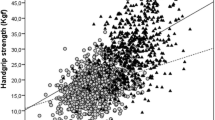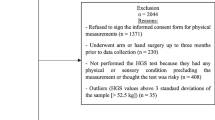Abstract
The handgrip strength is considered an excellent predictor of morbidity and mortality for acute and long term outcomes. In fact, several studies showed that the reduced handgrip strength is correlated to all-cause mortality in both middle aged and elderly subjects. Nevertheless, defined reference values of handgrip strength are not available, especially from young and healthy populations. The aim of this study was to determine the reference values for handgrip strength from a healthy population of young volunteers. A secondary objective was to derivate a muscle function T score useful for adults and elderly individuals. We enrolled 335 healthy university students (157 men and 178 females) aged 19–25 years. The handgrip strength was measured using a hydraulic hand dynamometer by trained dietitians. The mean handgrip strength value was 27.70 ± 4.3 kg for female and 44.77 ± 6.6 kg for male. We showed statistical difference between sexes. We also found the lower T score in community-dwelling elderly individuals in comparison to the young people. The muscle strength loss is a multi-factorial process influenced by age and hormonal factors. The availability of the reference values in both sexes might open the way to the diffusion of the handgrip strength assessment for more clinical use, and it might be useful to identify people who could benefit from early nutritional or pharmacological programs.


Similar content being viewed by others
References
R.W. Bohannon, R. Maljanian, J. Ferullo, Mortality and readmission of the elderly one year after hospitalization for pneumonia. Aging Clin. Exp. Res. 16, 22–25 (2004)
H. Sasaki, F. Kasagi, M. Yamada, S. Fujita, Grip strength predicts cause-specific mortality in middle-aged and elderly persons. Am. J. Med. 120, 337–342 (2007)
T. Rantanen, T. Harris, S.G. Leveille, M. Visser, D. Foley, K. Masaki, J.M. Guralnik, Muscle strength and body mass index as long-term predictors of mortality in initially healthy men. J. Gerontol. A Biol. Sci. Med. Sci. 55, M168–M173 (2000)
R.W. Bohannon, Hand-grip dynamometry predicts future outcomes in aging adults. J. Geriatr. Phys. Ther. 31, 3–10 (2008)
A. Kerr, H.E. Syddall, C. Cooper, G.F. Turner, R.S. Briggs, A.A. Sayer, Does admission grip strength predict length of stay in hospitalised older patients? Age Ageing 35, 82–84 (2006)
C.B. Guo, W. Zhang, D.Q. Ma, K.H. Zhang, J.Q. Huang, Hand grip strength: an indicator of nutritional state and the mix of postoperative complications in patients with oral and maxillofacial cancers. Br. J. Oral Maxillofac. Surg. 34, 325–327 (1996)
A.R. Webb, L.A. Newman, M. Taylor, J.B. Keogh, Hand grip dynamometry as a predictor of postoperative complications reappraisal using age standardized grip strengths. J. Parenter. Enteral. Nutr. 13, 30–33 (1989)
J. Humphreys, M.P. de la, S. Hirsch, G. arrera, V. Gattas, D. Bunout, Muscle strength as a predictor of loss of functional status in hospitalized patients. Nutrition 18, 616–620 (2002)
A.B. Newman, V. Kupelian, M. Visser, E.M. Simonsick, B.H. Goodpaster, S.B. Kritchevsky, F.A. Tylavsky, S.M. Rubin, T.B. Harris, Strength, but not muscle mass, is associated with mortality in the health, aging and body composition study cohort. J. Gerontol. A Biol. Sci. Med. Sci. 61, 72–77 (2006)
M.C. Barbosa-Silva, A.J. Barros, Indications and limitations of the use of subjective global assessment in clinical practice: an update. Curr. Opin. Clin. Nutr. Metab. Care 9, 263 (2006)
M.B. Budziareck, R.R. PurezaDuarte, M.C. Barbosa-Silva, Reference values and determinants for handgrip strength in healthy subjects. Clin. Nutr. 27, 357–362 (2008)
M. R. A′ lvares-da-Silva, T. R. Silveira, O estudo da forc¸a do aperto da ma˜ona˜o-dominanteemindivı′duossadios. Determinac¸a˜odosvalores de refereˆncia para o uso da dinamometria. GED 1998;17:203
L.E. Heredia, G.M. Pena, J.R. Galiana, Handgrip dynamometry in healthy adults. Clin. Nutr. 24, 250 (2005)
T. Montalcini, V. Migliaccio, Y. Ferro, C. Gazzaruso, A. Pujia, Androgens for postmenopausal women’s health? Endocrine (2012). doi:10.1007/s12020-012-9692-1
K. Sakuma, A. Yamaguchi, Sarcopenia and age-related endocrine function. Int. J. Endocrinol. 2012, 127362 (2012)
A.J. Wagenmakers, Muscle function in critically ill patients. Clin. Nutr. 20, 451e4 (2001)
S.M. Phillips, S.A. Atkinson, M.A. Tarnopolsky, J.D. MacDougall, Gender differences in leucine kinetics and nitrogen balance in endurance athletes. J. Appl. Physiol. 75, 2134–2141 (1993)
S. McKenzie, S.M. Phillips, S.L. Carter, S. Lowther, M.J. Gibala, M.A. Tarnopolsky, Endurance exercise training attenuates leucine oxidation and BCOAD activation during exercise in humans. Am. J. Physiol. Endocrinol. Metab. 278, E580–E587 (2000)
M.J. Hamadeh, M.C. Devries, M.A. Tarnopolsky, Estrogen supplementation reduces whole body leucine and carbohydrate oxidation and increases lipid oxidation in men during endurance exercise. J. Clin. Endocrinol. Metab. 90, 3592–3599 (2005)
M. Esbjornsson, J. Bulow, B. Norman, L. Simonsen, J. Nowak, O. Rooyackers, L. Kaijser, E. Jansson, Adipose tissue extracts plasma ammonia after sprint exercise in women and men. J. Appl. Physiol. 101, 1576–1580 (2006)
M. Esbjornsson, B. Norman, S. Suchdev, M. Viru, A. Lindhgren, E. Jansson, Greater growth hormone and insulin response in women than in men during repeated bouts of sprint exercise. Acta Physiol. 197, 107–115 (2009)
D.M. Russell, L.A. Leiter, J. Whitwell, E.B. Marliss, K.N. Jeejeebhoy, Skeletal muscle function during hypocaloric diets and fasting: a comparison with standard nutritional assessment parameters. Am. J. Clin. Nutr. 37, 133–138 (1983)
P. Steiger, Standardisation of measurements for assessing BMD by DXA. Calcif. Tissue Int. 57, 469 (1995)
Anonymous WHO Study Group, Assessment of fracture risk and its application to screening for post-menopausal osteoporosis (WHO, Geneva, 1994)
S.C. Forbes, J.P. Little, D.G. Candow, Exercise and nutritional interventions for improving aging muscle health. Endocrine. (2012) DOI 10.1007/s12020-012-9676-1
Conflict of interest
None.
Author information
Authors and Affiliations
Corresponding author
Rights and permissions
About this article
Cite this article
Montalcini, T., Migliaccio, V., Yvelise, F. et al. Reference values for handgrip strength in young people of both sexes. Endocrine 43, 342–345 (2013). https://doi.org/10.1007/s12020-012-9733-9
Received:
Accepted:
Published:
Issue Date:
DOI: https://doi.org/10.1007/s12020-012-9733-9




